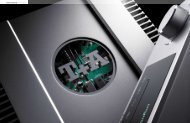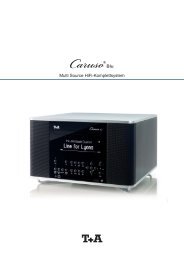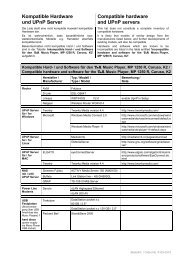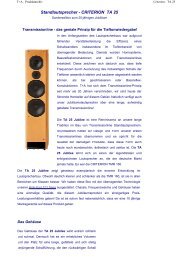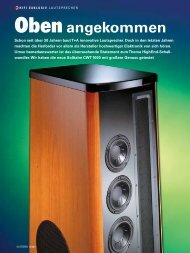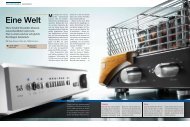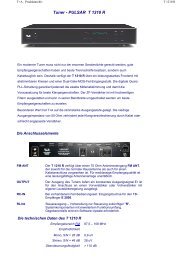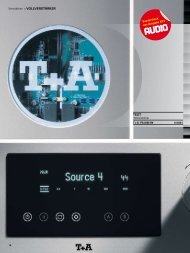BETRIEBSANLEITUNG USER MANUAL TALIS - T+A Elektroakustik
BETRIEBSANLEITUNG USER MANUAL TALIS - T+A Elektroakustik
BETRIEBSANLEITUNG USER MANUAL TALIS - T+A Elektroakustik
Erfolgreiche ePaper selbst erstellen
Machen Sie aus Ihren PDF Publikationen ein blätterbares Flipbook mit unserer einzigartigen Google optimierten e-Paper Software.
<strong>BETRIEBSANLEITUNG</strong><br />
<strong>USER</strong> <strong>MANUAL</strong><br />
<strong>TALIS</strong><br />
AKTIV / ACTIVE<br />
TLS 20 A<br />
TLS 10 A<br />
V 1.0 Bestell-Nr./Order no. 9103-0343
Seite / Page<br />
Deutsch 4<br />
English 12<br />
Technische Daten / Specifications 19<br />
3
Inhalt<br />
Auspacken ......................................................................................................................... 5<br />
Montagehinweise ............................................................................................................... 5<br />
Aufstellungshinweise ......................................................................................................... 6<br />
Bedienungs- und Anschlusselemente ............................................................................... 6<br />
Inbetriebnahme .................................................................................................................. 7<br />
• Verkabelung .................................................................................................................. 7<br />
• Anschluss an Endstufenausgänge ............................................................................... 8<br />
Sicherheitshinweise ........................................................................................................... 9<br />
Technische Daten .............................................................................................................. 19<br />
4
Auspacken<br />
Bitte packen Sie die <strong>TALIS</strong>-Lautsprecher und das Zubehör<br />
vorsichtig aus. Zum Lieferumfang gehören die folgenden<br />
Einzelteile:<br />
• 2 <strong>TALIS</strong>-Lautsprechergehäuse<br />
• 2 Bodenplatten<br />
• 2 Zwischenböden<br />
• 6 Rosetten aus Kunststoff<br />
• 6 Rosetten aus Metall<br />
• 6 Senkkopfschrauben M6<br />
• 1 Bedienungsanleitung<br />
• 2 Netzkabel<br />
• 1 Garantiekarte<br />
Heben Sie die Originalverpackung zusammengefaltet<br />
auf. Der Karton und das Verpackungsmaterial sind speziell<br />
für diese Boxen konzipiert. Sie stellen einen sicheren<br />
Behälter für spätere Transporte dar und erhalten den<br />
Wiederverkaufswert der Lautsprecherboxen.<br />
Falls Sie die Verpackung nicht mehr benötigen, geben<br />
Sie diese Ihrem Händler zurück, um eine fachgerechte<br />
Entsorgung zu gewährleisten.<br />
Montagehinweise<br />
Zu den <strong>TALIS</strong>-Lautsprechern TLS 20A und TLS 10A<br />
werden Bodenplatten mitgeliefert. Vor der Inbetriebnahme<br />
müssen diese Bodenplatten an die Lautsprecher<br />
montiert werden, um ausreichend Standsicherheit zu<br />
erhalten.<br />
Falls Sie sich für Bodenplatten aus Glas entschieden<br />
haben, ist es erforderlich, sehr vorsichtig damit umzugehen.<br />
Um Bruch zu vermeiden, sollten die Glasplatten<br />
nicht geworfen oder auf die Ecken gestoßen werden.<br />
Zur Montage ist der Lautsprecher kopfüber auf eine nicht<br />
kratzende Unterlage zu stellen. Der Zwischenboden und<br />
die Glasplatte werden vorsichtig so aufgelegt, dass die<br />
Montagelöcher übereinander liegen. Die Schrauben<br />
werden zusammen mit den Rosetten (siehe Zeichnung)<br />
nur leicht von Hand angeschraubt, um das Glas nicht zu<br />
beschädigen.<br />
Nach Montage der Glasplatte wird der Lautsprecher<br />
wieder herumgedreht und ist spielbereit.<br />
Die Glasplatten sind rückseitig mit einer Farbfolie beschichtet.<br />
Wird diese Folie beschädigt, so werden die<br />
Kratzer auf der Oberseite sichtbar.<br />
Bei der Aufstellung der Lautsprecher sollten diese niemals<br />
über den Boden geschoben werden, um Kratzer auf<br />
der Unterseite der Glasplatten zu vermeiden.<br />
Die Lautsprecher der <strong>TALIS</strong>-Serie werden mit einer<br />
Frontabdeckung ausgeliefert. Diese besteht aus einem<br />
mit Vlies hinterlegten Gitter. Es dient dem Schutz der<br />
Lautsprecherchassis.<br />
Die Gitter können und sollten nicht entfernt werden. Sie<br />
sind Bestandteil des akustischen Systems. Eine Entfernung<br />
führt zur Beschädigung der Gitter und zu einer<br />
Verschlechterung des Klangbildes.<br />
5
Aufstellungshinweise<br />
Die beiden Lautsprecher sind durch einen Aufkleber als<br />
rechte bzw. linke Box gekennzeichnet. Sie sind durch<br />
ihre interne Beschaltung so festgelegt.<br />
Die beiden Frontlautsprecher sollten so platziert sein,<br />
dass die Entfernung zwischen den Boxen und die zum<br />
Hörer ungefähr ein gleichseitiges Dreieck bildet.<br />
Der minimale Hörabstand sollte 2 Meter nicht unterschreiten.<br />
Daraus ergibt sich nach der o. g. Dreiecksregel<br />
ein Mindestabstand der Lautsprecher zueinander von<br />
2 Metern.<br />
Die <strong>TALIS</strong> Standlautsprecher sollten in einem Abstand<br />
von mindestens 1,50 Meter vom TV-Gerät aufgestellt<br />
werden, da es sonst unter Umständen zu Farbveränderungen<br />
des Bildes führen kann.<br />
Der Centerlautsprecher besitzt magnetisch abgeschirmte<br />
Lautsprecherchassis. Er kann in unmittelbarer Nähe zum<br />
TV-Gerät betrieben werden.<br />
Berücksichtigen Sie, dass die Basswiedergabe durch<br />
eine Positionierung der Boxen an der Wand um ca. 3 dB,<br />
in der Raumecke bis zu 6 dB angehoben wird.<br />
Bei zu starker Basswiedergabe sollten die Lautsprecher<br />
etwas aus der Ecke bzw. von der Wand abgerückt werden.<br />
Hinweis:<br />
Für die Aufstellung in unmittelbarer Nähe eines TV-Gerätes<br />
sind die <strong>TALIS</strong>-Standlautsprecher optional mit<br />
abgeschirmten Chassis erhältlich.<br />
Bedienungs- und Anschlusselemente<br />
<br />
Schalter des internen Filters für den Tiefbassbereich.<br />
Werden die <strong>TALIS</strong>-Aktivboxen mit einem<br />
zusätzlichen Subwoofer betrieben, so sollte das<br />
Filter auf ON stehen.<br />
Dadurch werden sehr tieffrequente Musikanteile<br />
herausgefiltert, um die Belastbarkeit der Lautsprecher<br />
zu erhöhen. Ohne zusätzlichen Subwoofer<br />
sollte das Filter auf OFF stehen, um auch<br />
Tiefbassanteile zu übertragen.<br />
<br />
DIN-Eingangsbuchse.<br />
DIN-Ausgangsbuchse zum Anschluss des<br />
2. Lautsprechers oder eines Subwoofers.<br />
<br />
Netz Eingangsbuchse.<br />
Achtung:<br />
Die <strong>TALIS</strong>-Aktivlautsprecher dürfen nur an einer dem<br />
Aufdruck entsprechenden Netzspannung betrieben werden.<br />
6
Inbetriebnahme<br />
Die <strong>TALIS</strong>-Aktivlautsprecher besitzen einen internen<br />
elektronischen Netzschalter. Die Aktivierung erfolgt über<br />
eine Schaltspannung, welche an der DIN-Eingangsbuchse<br />
(Pin 4) angelegt werden muss. Das Quellgerät,<br />
mit dem Sie die Lautsprecher betreiben wollen, muss<br />
eine entsprechende DIN-Ausgangsbuchse besitzen. Wird<br />
das Quellgerät eingeschaltet, so aktivieren sich automatisch<br />
die Aktivboxen.<br />
Hinweis:<br />
In Standby Betrieb verbraucht die Box keine Leistung.<br />
Hinweis:<br />
Für Geräte, die über keine geschaltete DIN-Ausgangsbuchse<br />
verfügen, ist im Zubehör ein Adapter enthalten.<br />
Er besitzt einen Klinkenstecker, an welchem eine Spannung<br />
zwischen +5 und +20 V angelegt werden muss, um<br />
die Lautsprecher einzuschalten.<br />
Bei -Geräten ohne DIN-Ausgangsbuchse wird dieser<br />
Klinkenstecker mit der CTRL-Out-Buchse verbunden.<br />
Bei Fremdgeräten oder -Geräten ohne CTRL-<br />
Buchse muss ein Schaltspannungsausgang nachgerüstet<br />
werden. Bitte wenden Sie sich in diesem Falle an Ihren<br />
Fachhändler.<br />
Die Cinch Stecker des Adapters müssen mit den Signal-<br />
Ausgangsbuchsen des Quellgerätes verbunden werden.<br />
Verkabelung:<br />
Verbinden Sie zuerst die Netzbuchsen auf der Rückseite<br />
der Lautsprecher mit Hilfe der mitgelieferten Kabel mit<br />
jeweils einer geschalteten Netz-Steckdose.<br />
Verbinden Sie nun die DIN-Eingangsbuchse an der<br />
Rückseite des 1. Lautsprechers mit der Ausgangsbuchse<br />
Ihres Quellgerätes.<br />
Falls Ihr Quellgerät keine DIN-Ausgangsbuchse besitzt,<br />
verwenden Sie den mitgelieferten Adapter zum Anschluss<br />
an einen Cinch Vorverstärker-Ausgang.<br />
Sollte ein Cinch Vorverstärker-Ausgang an Ihrem Quellgerät<br />
nicht vorhanden sein, so lesen Sie bitte im Abschnitt<br />
'Anschluss an Endstufenausgänge' nach.<br />
Als nächstes muss eine Verbindung zwischen der DIN-<br />
Ausgangsbuchse des 1. Lautsprechers mit der Eingangsbuchse<br />
des 2. Lautsprechers hergestellt werden.<br />
Verwenden Sie dazu das zweite mitgelieferte DIN-Verbindungskabel.<br />
Hinweis:<br />
Die beiden Lautsprecher sind durch einen Aufkleber als<br />
rechte bzw. linke Box gekennzeichnet. Ob Sie als<br />
1. Lautsprecher der Verbindungsreihenfolge die rechte<br />
oder linke Box verwenden, beeinflusst die Funktion der<br />
Lautsprecher nicht.<br />
Hiermit ist die Verkabelung abgeschlossen. Die Lautsprecher<br />
sind nun spielbereit. Wenn Sie nun die<br />
Netzspannung einschalten, so schalten sich automatisch<br />
die <strong>TALIS</strong>-Aktivlautsprecher ein. Dieser Zustand wird<br />
Ihnen durch eine grüne Leuchtdiode hinter dem Gitter am<br />
unteren Teil der Front angezeigt.<br />
7
Die <strong>TALIS</strong>-Aktivlautsprecher besitzen eine Einschaltverzögerung.<br />
Diese dient dem Schutz der Lautsprecherchassis<br />
vor Spannungsspitzen beim Einschalten. Dadurch<br />
dauert es ca. 10 Sekunden bis die Aktivboxen<br />
spielbereit sind.<br />
Falls Sie einen Subwoofer integrieren wollen, können Sie<br />
diesen an die DIN-Ausgangsbuchse des zweiten Lautsprechers<br />
anschließen.<br />
Falls der Subwoofer keine entsprechende Eingangbuchse<br />
besitzt, kann ein weiterer Adapter verwendet<br />
werden, um die Cinch-Eingänge zu verwenden. Der<br />
Adapter und das entsprechende DIN-Verbindungskabel<br />
sind als Zubehör beim -Fachhändler erhältlich.<br />
Wenn Ihr Subwoofer über einen Schaltspannungseingang<br />
verfügt, so können Sie diesen mit dem Klinkenstecker<br />
des 2. Adapters verbinden. Sollten Sie diesen<br />
Klinkenstecker nicht benötigen, so belassen Sie die mitgelieferte<br />
Abdeckkappe auf dem Stecker, um evtl. Kurzschlüsse<br />
mit anderen Geräten zu vermeiden.<br />
Anschluss an Endstufenausgänge<br />
Wenn Sie die <strong>TALIS</strong> Aktivlautsprecher an ein Quellgerät<br />
(z. B. Endstufe) ohne passende Cinch Ausgänge anschließen<br />
wollen, benötigen Sie eine zusätzliche Adapterbox.<br />
Damit ist es möglich, die Aktivlautsprecher an den<br />
Lautsprecherausgang eines Quellgerätes anzuschließen.<br />
Diese Adapterbox ist als Zubehör beim -Fachhändler<br />
erhältlich.<br />
Wie in diesem Falle die Geräte miteinander zu verkabeln<br />
sind, ist in folgendem Bild zu sehen:<br />
8
Sicherheitshinweise<br />
Bitte lesen Sie die Bedienungsanleitung vor Gebrauch<br />
der Anlage sorgfältig durch. Befolgen Sie unbedingt die<br />
folgenden Sicherheitsvorschriften!<br />
1. Die Aktivlautsprecher dürfen nur in trockenen Räumen<br />
betrieben werden. Es ist darauf zu achten, dass<br />
sie für kleine Kinder unerreichbar sind.<br />
2. Es dürfen keine Flüssigkeiten oder Fremdkörper in<br />
das Gerät gelangen. Sollte dennoch eine Flüssigkeit<br />
oder ein Fremdkörper in das Gerät gelangt sein, ziehen<br />
Sie sofort den Netzstecker und lassen das Gerät<br />
in einer autorisierten Fachwerkstatt überprüfen!<br />
3. Wie alle Elektrogeräte, so sollten auch diese Aktivboxen<br />
nicht unbeaufsichtigt betrieben werden.<br />
4. Bei längerer Nichtbenutzung sollte der Netzstecker<br />
der Geräte aus der Steckdose gezogen werden.<br />
5. Waren die Aktivlautsprecher größerer Kälte ausgesetzt<br />
(z. B. beim Transport), so ist mit der Inbetriebnahme<br />
zu warten, bis sie sich auf Raumtemperatur<br />
aufgewärmt haben und das Kondenswasser restlos<br />
verdunstet ist.<br />
6. Beim Aufstellen ist darauf zu achten, dass die Kühlluftzufuhr<br />
zum Gehäuse nicht behindert wird.<br />
<br />
Ein Wärmestau beeinträchtigt die Lebensdauer<br />
des Gerätes und ist eine Gefahrenquelle!<br />
7. Die erforderliche Stromversorgung ist dem Aufdruck<br />
an der Lautsprecherrückwand zu entnehmen. An andere<br />
Stromversorgungen darf das Gerät nicht angeschlossen<br />
werden.<br />
9. Die Lautsprecher sind so aufzustellen, dass eine<br />
Berührung sämtlicher Geräteanschlüsse (insbesondere<br />
durch Kinder) ausgeschlossen ist.<br />
10. Außer den in der Bedienungsanleitung beschriebenen<br />
Handgriffen sollten vom Benutzer keinerlei Arbeiten<br />
am Gerät vorgenommen werden.<br />
11. Die Lautsprecher dürfen nur vom qualifizierten Fachmann<br />
geöffnet werden. Reparaturen und das Auswechseln<br />
von Sicherungen sind von einer autorisierten<br />
Fachwerkstatt durchzuführen.<br />
12. Bei Beschädigungen oder bei Verdacht auf eine nicht<br />
ordnungsgemäße Funktion der Geräte sollte sofort<br />
der Netzstecker gezogen, und die Geräte zur Überprüfung<br />
in eine autorisierte Fachwerkstatt gegeben<br />
werden.<br />
13. Pflege des Gerätes.<br />
<br />
Eine<br />
• Vor Reinigungsarbeiten an den Lautsprechern ist<br />
der Netzstecker zu ziehen!<br />
• Verwenden Sie keine scharfen Reinigungs- oder<br />
Lösungsmittel!<br />
• Vor der Wiederinbetriebnahme muss sichergestellt<br />
sein, dass keine Kurzschlüsse an den Anschlussstellen<br />
bestehen und dass alle Anschlüsse ordnungsgemäß<br />
sind.<br />
Entsorgung dieses Produkts darf nur<br />
über die Sammelstelle für Elektroschrott<br />
erfolgen.<br />
8. Das Netzkabel muss so verlegt werden, dass keine<br />
Gefahr der Beschädigung (z. B. durch Trittbelastung<br />
oder durch Möbelstücke) besteht. Besondere Vorsicht<br />
ist dabei an den Steckern, Verteilern und an der Netz<br />
Eingangsbuchse der Boxen geboten. Auf den Netzstecker<br />
darf keine übermäßige Krafteinwirkung ausgeübt<br />
werden!<br />
9
English<br />
11
Contents<br />
Unpacking .......................................................................................................................... 11<br />
Assembling the speakers ................................................................................................... 11<br />
Setting up the speakers ..................................................................................................... 12<br />
Controls and connections .................................................................................................. 12<br />
Using the speakers for the first time .................................................................................. 13<br />
• Wiring ............................................................................................................................ 13<br />
• Connection to power amplifier outputs ......................................................................... 16<br />
Safety notes ....................................................................................................................... 14<br />
Specification ....................................................................................................................... 19<br />
12
Unpacking<br />
Please unpack your <strong>TALIS</strong> loudspeakers and accessories<br />
very carefully. The contents of the set are as follows:<br />
• 2 <strong>TALIS</strong> loudspeaker cabinets<br />
• 2 base plates<br />
• 2 spacers<br />
• 6 plastic spreaders<br />
• 6 metal spreaders<br />
• 6 M6 countersunk screws<br />
• 1 set of operating instructions<br />
• 2 mains leads<br />
Fold up the original packaging and store it in a safe<br />
place. The carton and packing materials have been specially<br />
designed for these loudspeakers. They form a safe<br />
container should you need to transport the speakers at<br />
any time, and they also help to maintain the speakers’<br />
second-hand value.<br />
If you don’t wish to keep the packaging, give the material<br />
back to your supplier for appropriate disposal.<br />
Assembling the speakers<br />
<strong>TALIS</strong> TLS 20A and TLS 10A loudspeakers are supplied<br />
with separate base plates. The base plates must be<br />
attached to the cabinets before you use the speakers to<br />
ensure that they are stable when erected.<br />
If you have purchased glass base plates please be extremely<br />
careful with them to avoid breaking the glass. Don’t<br />
drop or throw the glass plates, and take care not to hit the<br />
edges and corners on any hard object.<br />
To assemble the loudspeakers stand them on a surface<br />
which will not cause scratches and turn them upside-down.<br />
Carefully place the spacer and the glass plate on the cabinet<br />
bottom and line up the screw-holes. Fit the screws and<br />
the spreaders (see drawing), and tighten the screws gently.<br />
Tighten them by hand only to avoid damaging the glass.<br />
Carefully turn the speaker the right way up once the glass<br />
plate has been fitted; it is now ready for use.<br />
The reverse face of the glass plates is coated with a<br />
coloured film. Take care not to damage this film as any<br />
scratches will be visible on the top surface.<br />
When positioning the loudspeakers never push them along<br />
the floor as this will scratch the underside of the glass<br />
plates.<br />
<strong>TALIS</strong> series loudspeakers are supplied with a front cover.<br />
This consists of a grille lined with a fibrous material, and is<br />
designed to protect the drive units.<br />
The grilles cannot and must not be removed, as they are<br />
an integral part of the loudspeakers’ acoustic system.<br />
Any attempt at removal will damage the grilles and have<br />
an adverse effect on the sound image.<br />
13
Setting up the speakers<br />
Each loudspeaker bears a sticker denoting the left and right<br />
unit. They are internally wired for this configuration.<br />
The two front speakers should be positioned in such a way<br />
that they and the listener form the three points of an<br />
approximately equi-lateral triangle.<br />
The minimum listening distance is two metres, and this<br />
should always be observed. This means that the speakers<br />
should also be at least two metres apart in order to satisfy<br />
the triangle rule.<br />
<strong>TALIS</strong> floor-standing loudspeakers should be positioned at<br />
least 1.50 metres from your TV set, otherwise they could<br />
cause discoloration of the screen image under unfavourable<br />
circumstances.<br />
The centre speaker features magnetically shielded drive<br />
units as standard, and can safely be used immediately<br />
adjacent to the TV set.<br />
Please bear in mind that the bass response of the loudspeakers<br />
varies according to their position relative to the<br />
wall. Placing them against a wall raises the bass response<br />
by about 3 dB, and positioning them in the corners of a<br />
room increases bass response by about 6 dB.<br />
If you find the bass response excessive, move the speakers<br />
slightly out of the corners or away from the wall.<br />
Note:<br />
As an option <strong>TALIS</strong> floor-standing speakers are<br />
available fitted with shielded drive units, should you<br />
wish to position immediately adjacent to your<br />
television.<br />
Controls and connections<br />
<br />
Internal filter switch for the low bass range. If you<br />
intend to operate the <strong>TALIS</strong> active speakers in<br />
conjunction with a separate sub-woofer, the filter<br />
should be set to ON.<br />
This filters out the extreme low-frequency part of<br />
the music signal, and thereby increases the<br />
speakers’ maximum load capacity. The filter<br />
should be set to OFF if your system does not include<br />
a separate sub-woofer, so that the speakers<br />
transmit the full bass range.<br />
<br />
DIN input socket.<br />
<br />
DIN output socket for connecting the second<br />
loudspeaker or a sub-woofer.<br />
<br />
Mains input socket.<br />
Caution:<br />
<strong>TALIS</strong> active loudspeakers must only be connected to a<br />
mains supply which satisfies the printed specification.<br />
14
Using the loudspeakers for the first time<br />
<strong>TALIS</strong> active loudspeakers feature an internal electronic<br />
mains switch. The switch is activated by a switching voltage<br />
which must be present at pin 4 of the DIN input socket. The<br />
source device with which you wish to operate the loudspeakers<br />
must therefore include a suitable DIN output<br />
socket. The active speakers will then activate themselves<br />
automatically when the source device is switched on.<br />
Note:<br />
In stand-by mode the speakers require no power.<br />
Note:<br />
The speakers are supplied as standard with an accessory<br />
adaptor for use with devices which do not feature a<br />
switched DIN output socket. This includes a barrel plug to<br />
which a voltage in the range +5 to +20 V must be applied in<br />
order to switch on the speakers.<br />
If you are using a device without a DIN output socket,<br />
connect the barrel plug to the CTRL-Out socket.<br />
If you are using a different make of device, or a unit<br />
without a CTRL socket, it will be necessary to retro-fit a<br />
switching voltage output. Please ask your specialist dealer<br />
for details of this.<br />
The Cinch plugs attached to the adaptor must be<br />
connected to the signal output sockets of the source<br />
device.<br />
Wiring:<br />
First connect the mains sockets on the rear face of the<br />
loudspeakers using the mains leads supplied; connect each<br />
plug to a separate switched mains outlet socket.<br />
Connect the DIN input socket on the rear face of the first<br />
loudspeaker to the DIN output socket of your source<br />
device.<br />
If your source device does not feature a DIN output socket,<br />
use the adaptor (supplied) to connect the speaker to a<br />
Cinch pre-amplifier output.<br />
If your source device does not include a Cinch pre-amplifier<br />
output, please read the section entitled „Connection to<br />
power amplifier outputs“.<br />
The next step is to complete the connection between the<br />
DIN output socket of the first loudspeaker and the input<br />
socket of the second speaker. This is carried out using the<br />
second DIN connecting lead supplied with the speakers.<br />
Note:<br />
The two loudspeakers bear stickers marked left and right.<br />
You can use the right or left speaker as the first unit in the<br />
connection sequence; this has no influence on the operation<br />
of the loudspeakers.<br />
This completes the wiring process, and the speakers are<br />
ready for use. If you now switch on the source device, the<br />
<strong>TALIS</strong> active loudspeakers will switch themselves on automatically.<br />
A green LED lights up to indicate the ready<br />
status. The LED is located behind the grille on the lower<br />
part of the front panel.<br />
15
<strong>TALIS</strong> active loudspeakers feature a power-on delay. The<br />
purpose of this is to protect the drive units from voltage<br />
surges which occur when power is initially switched on. The<br />
delay is about ten seconds, i. e. you have to wait until the<br />
active speakers are ready to work.<br />
If you wish to integrate a sub-woofer into your system, this<br />
can be connected to the DIN output socket of the second<br />
loudspeaker.<br />
If the sub-woofer does not feature a corresponding input<br />
socket, you can use the Cinch inputs with the help of a<br />
second adaptor. The adaptor and matching DIN connecting<br />
lead are available as accessories from your specialist <br />
dealer.<br />
If your sub-woofer features a switching voltage input, you<br />
can connect this to the barrel plug attached to the second<br />
adaptor. If you don’t need to use the barrel plug, leave the<br />
plastic cap on it to avoid possible short-circuits with other<br />
devices.<br />
Connection to power amplifier outputs<br />
If you wish to connect your <strong>TALIS</strong> active loudspeakers to a<br />
source device (e. g. power amplifier) which does not have<br />
suitable Cinch outputs, you will require a separate adaptor<br />
box. This enables you to connect the active loudspeakers<br />
to the loudspeaker output of a source device.<br />
This adaptor box is available as an accessory from your<br />
specialist dealer.<br />
The following diagram shows how the units have to be<br />
connected together in this configuration:<br />
16
Safety notes<br />
For your own safety please be sure to read right through<br />
these operating instructions before you use the system. It is<br />
especially important to observe the following safety notes.<br />
1. The active loudspeakers may only be operated in a dry<br />
indoor room. Ensure that they are kept out of the reach<br />
of small children.<br />
2. Do not allow any liquid or foreign bodies to enter the<br />
speakers. If any liquid or foreign body should penetrate<br />
the cabinet despite your best efforts, immediately disconnect<br />
the mains plug at the wall socket, and have the<br />
unit checked by an authorised service workshop.<br />
3. These active loudspeakers should never be operated<br />
without proper supervision. This applies to all electrical<br />
equipment.<br />
4. If the speakers are not to be used for a long period, we<br />
recommend that you isolate them from the mains by<br />
pulling out the plug at the wall socket.<br />
5. If the active loudspeakers get very cold (e. g. when<br />
being transported) condensation may form inside them.<br />
Please do not switch them on until they have had plenty<br />
of time to warm up to room temperature, so that any<br />
condensation evaporates completely.<br />
9. The loudspeakers must be set up in such a way that<br />
there is no chance of anyone - especially children -<br />
touching the electrical connections.<br />
10. With the exception of the connections and procedures<br />
described in these instructions, no work of any kind may<br />
be carried out on the loudspeakers by the user.<br />
11. The loudspeakers should only ever be opened by a<br />
qualified technician. Repairs and fuse replacements<br />
should be entrusted to an authorised specialist<br />
workshop.<br />
12. If a speaker should be damaged, or if you suspect that<br />
it is not functioning correctly, immediately disconnect<br />
the mains plug at the wall socket and ask an authorised<br />
specialist workshop to check the unit.<br />
13. Care of the loudspeakers<br />
• Always disconnect the loudspeakers from the mains<br />
supply before cleaning them.<br />
• Never use abrasive or solvent-based cleaning agents.<br />
• Before switching the loudspeakers on again, check<br />
carefully that no short-circuits exist at the terminals,<br />
and that you have not disturbed any connections.<br />
6. When setting up the speakers, ensure that there is an<br />
unhindered flow of cooling air to and around the<br />
cabinets.<br />
<br />
Any heat build-up will shorten the life of the<br />
speakers, and could be a source of danger!<br />
7. The power supply required for these loudspeakers is<br />
printed on the rear face of the cabinet. The speakers<br />
must never be connected to any other form of power<br />
supply.<br />
8. The mains leads must be deployed in such a way<br />
that there is no danger of damage from furniture, or<br />
from people treading on them. Take particular care<br />
with plugs, distribution panels and the mains input<br />
sockets on the speakers. Never exert undue force on<br />
the mains plugs.<br />
<br />
The<br />
only permissible method of disposing of<br />
this product is to take it to your local collection<br />
centre for electrical waste.<br />
17
Technische Daten / Specification<br />
2 ½-Wege vollaktiver Lautsprecher mit 3 Gegentakt-Leistungsendstufen und aktiver Frequenzweiche<br />
2 ½-way fully active loudspeaker with three push-pull power amplifiers and active cross-over<br />
TLS 20 A<br />
TLS 10 A<br />
Eingangsempfindlichkeit für Vollaussteuerung / Input sensitivity for full output<br />
1 V eff<br />
Eingangsimpedanz / Input impedance<br />
10 kΩ<br />
Nennleistung / Nominal output<br />
3 x 60 W<br />
Impulsleistung / Peak output<br />
3 x 100 W<br />
Einschaltverzögerung / Power-on delay<br />
10 s<br />
Leistungsaufnahme / Power consumption Maximal / maximum 200 W 250 W<br />
Klirrfaktor / Total harmonic distortion 100 dB<br />
Bestückung Hochton / High-frequency drive unit 1 x 20 mm 1 x 35 mm<br />
Bestückung Tief-u. Mittelton / Bass / mid-range drive units 3 x 80 mm 4 x 140 mm<br />
Übertragungsbereich / Frequency response 40 Hz – 45 kHz 28 Hz – 45 kHz<br />
Trennfrequenzen / Cross-over frequencies (250), 2000 Hz (250), 2500 Hz<br />
Technische Änderungen vorbehalten. / We reserve the right to alter specifications.<br />
19
elektroakustik GmbH & Co. KG<br />
Herford<br />
Deutschland * Germany




